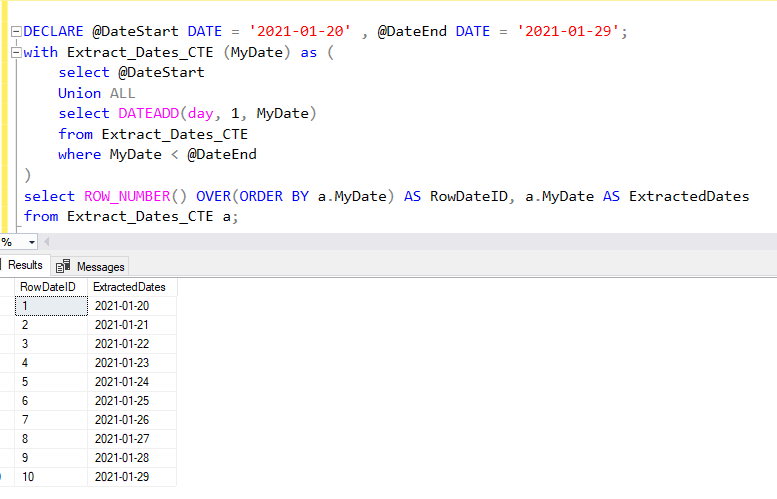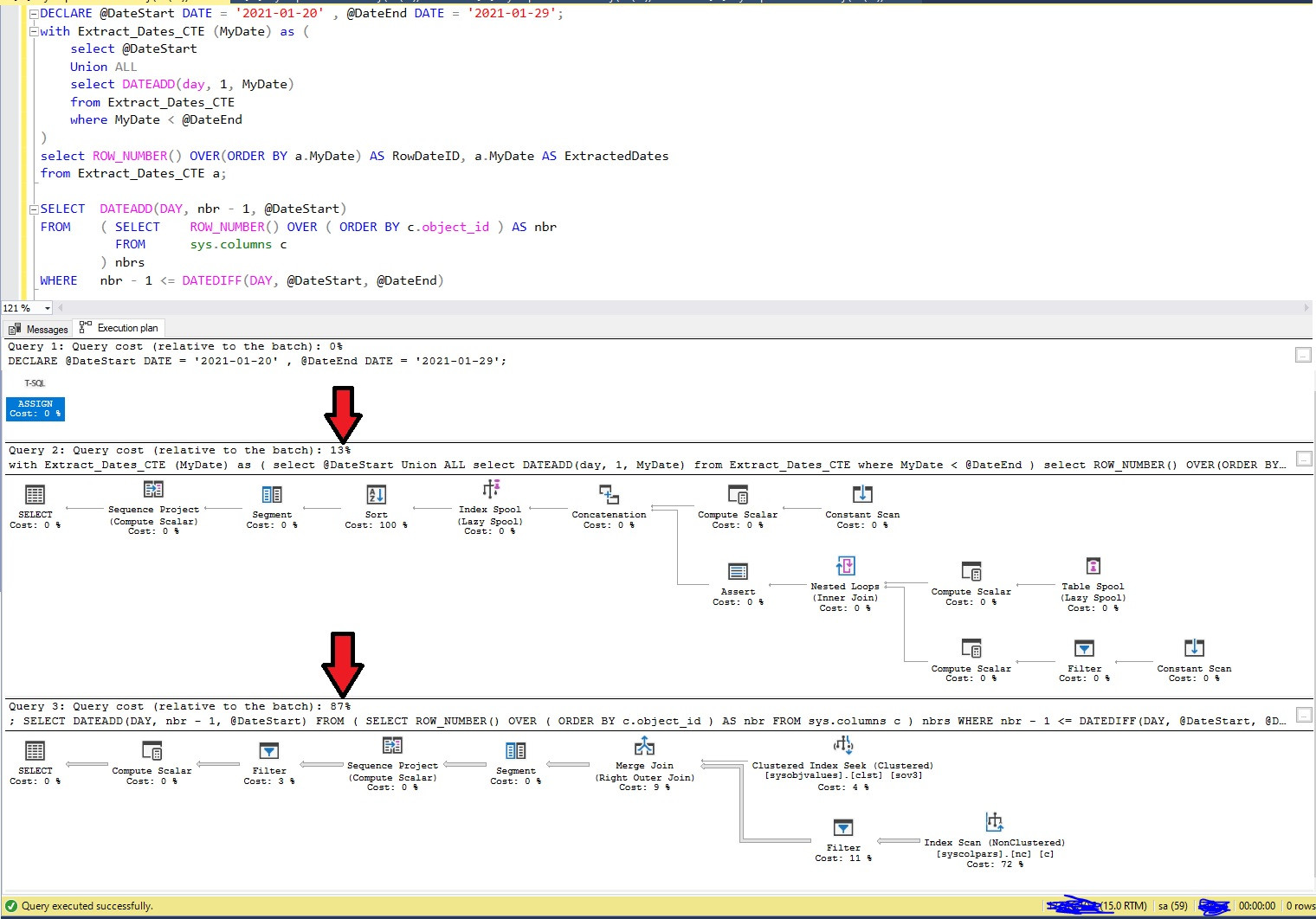Reputation: 46322
Generate Dates between date ranges
I need to populate a table that will store the date ranges between 2 given dates: 09/01/11 - 10/10/11
So in this case the table would start from 09/01/11 and store each day till it got to 10/10/11 I was wondering if there was a slick way of doing this in SQL Server - I am currently using SQL Server 2008. Thanks
Upvotes: 63
Views: 172177
Answers (15)

Reputation: 836
Using @Abe Miesler's answer, for other's convenience I built it into a TVF for SQL Server 2008 onwards. It may help others - I had to find a way to include the CTE inside the TVF!
--Generate a range of dates with interval option, courtesy of Abe Miessler for the core query here!
CREATE OR ALTER FUNCTION [dbo].[DateRange]
(@startDate AS DATE,
@EndDate AS DATE,
@interval AS INT
)
RETURNS @Dates TABLE(dateValue DATE)
AS
BEGIN
WITH Dates
AS (
SELECT [Date] = CONVERT( DATETIME, @startDate)
UNION ALL
SELECT [Date] = DATEADD(DAY, ISNULL(@interval, 1), [Date])
FROM Dates
WHERE Date < @EndDate)
INSERT INTO @Dates
SELECT [Date]
FROM Dates
OPTION(MAXRECURSION 900);
RETURN;
END;
Upvotes: 0
Reputation: 7
I use the ANSI standard SQL dialect on Databricks and the code below it`s a simpler way of creating month rows:
SELECT
EXPLODE(
SEQUENCE(
CURRENT_DATE() + MAKE_INTERVAL(0, -11),
CURRENT_DATE() + MAKE_INTERVAL(0, 1),
INTERVAL 1 MONTH))
Upvotes: -1
Reputation: 374
This is pretty easy to do if your database supports recursive common table expressions.
Here is an example on MySQL 8.
WITH
RECURSIVE
my_dates AS (
SELECT
date('2021-10-01') as s
UNION ALL
SELECT
DATE_ADD(s, INTERVAL 1 DAY)
from
my_dates
WHERE
s < '2022-10-31' # Desired End Date
)
SELECT
*
FROM
my_dates;
You can use DATE_SUB() if you want the dates to count backwards, for example and adjust the where clause accordingly. You can also increment the dates by more than one day as desired by simply doing the date calculation with more than one day interval.
Reference: https://nucco.org/2023/02/generate-a-series-of-dates-in-sql.html
Upvotes: -2

Reputation: 37
Recursive query is a good alternative when we cannot create functions in the database.
MySQL 8+ & MariaDB 10.2.2+
WITH RECURSIVE dates AS (
SELECT '2022-01-01' AS _day -- Your start date
UNION ALL
SELECT DATE_ADD(_day, INTERVAL 1 DAY)
FROM dates
WHERE _day < '2022-10-12' -- Your end date
)
Postgres 11+
WITH RECURSIVE dates AS (
SELECT DATE('2022-01-01') AS _day -- Your start date
UNION ALL
SELECT DATE(_day + INTERVAL '1 day')
FROM dates
WHERE _day < '2022-10-12' -- Your end date
)
To join these dates in your SELECT statement, you can use a JOIN dates ON true to replicate your rows for each date in your date range.
[WITH statement according to your database]
SELECT col1, col2, _day
FROM my_table
JOIN dates ON true
Upvotes: -1
Reputation: 62564
-- Declarations
DECLARE @dates TABLE(dt DATE)
DECLARE @dateFrom DATE
DECLARE @dateTo DATE
SET @dateFrom = '2001/01/01'
SET @dateTo = '2001/01/12'
-- Query:
WHILE(@dateFrom <= @dateTo)
BEGIN
INSERT INTO @dates
SELECT @dateFrom
SELECT @dateFrom = DATEADD(day, 1, @dateFrom)
END
-- Output
SELECT * FROM @dates
Upvotes: 19
Reputation: 12940
Easy on SQL 2005+; easier if you have a numbers or tally table. I faked it below:
DECLARE @StartDate DATE = '20110901'
, @EndDate DATE = '20111001'
SELECT DATEADD(DAY, nbr - 1, @StartDate)
FROM ( SELECT ROW_NUMBER() OVER ( ORDER BY c.object_id ) AS nbr
FROM sys.columns c
) nbrs
WHERE nbr - 1 <= DATEDIFF(DAY, @StartDate, @EndDate)
If you have a tally table, replace the subquery with the table. No recursion.
EDIT: Since folks seem to have questions about the tally table, let me rewrite this using a zero-based tally table. First, here's some code to create and populate a table.
CREATE TABLE [dbo].[nbrs](
[nbr] [INT] NOT NULL
) ON [PRIMARY]
GO
CREATE UNIQUE CLUSTERED INDEX [clidx] ON [dbo].[nbrs]
(
[nbr] ASC
)
GO
INSERT INTO dbo.nbrs (nbr)
SELECT nbr-1
FROM ( SELECT ROW_NUMBER() OVER ( ORDER BY c.object_id ) AS nbr
FROM sys.columns c
) nbrs
GO
Now, that you have the numbers table as a permanent object in your database, you can reuse it for the query INSTEAD of the subquery. The query has also been edited to use a zero-based calculation.
DECLARE @StartDate DATE = '20110901'
, @EndDate DATE = '20111001'
SELECT DATEADD(DAY, nbr, @DateStart)
FROM nbrs
WHERE nbr <= DATEDIFF(DAY, @DateStart, @DateEnd)
Performant, and no recursion.
Upvotes: 84

Reputation: 1328
Try Following CODE:
DECLARE @DateStart DATE = '2021-01-20' , @DateEnd DATE = '2021-01-29';
with Extract_Dates_CTE (MyDate) as (
select @DateStart
Union ALL
select DATEADD(day, 1, MyDate)
from Extract_Dates_CTE
where MyDate < @DateEnd
)
select ROW_NUMBER() OVER(ORDER BY a.MyDate) AS RowDateID, a.MyDate AS ExtractedDates
from Extract_Dates_CTE a;
Examining the performance, I found that using the CTE method has a better performance that I have shown in the figure. For this purpose, I used two queries and displayed the performance using the SQL Server tool.
DECLARE @DateStart DATE = '2021-01-20' , @DateEnd DATE = '2021-01-29';
with Extract_Dates_CTE (MyDate) as (
select @DateStart
Union ALL
select DATEADD(day, 1, MyDate)
from Extract_Dates_CTE
where MyDate < @DateEnd
)
select ROW_NUMBER() OVER(ORDER BY a.MyDate) AS RowDateID, a.MyDate AS ExtractedDates
from Extract_Dates_CTE a;
SELECT DATEADD(DAY, nbr - 1, @DateStart)
FROM ( SELECT ROW_NUMBER() OVER ( ORDER BY c.object_id ) AS nbr
FROM sys.columns c
) nbrs
WHERE nbr - 1 <= DATEDIFF(DAY, @DateStart, @DateEnd)
Upvotes: 1
Reputation: 1675
This is an old thread, but in case it helps anyone, this is what I use in modern versions of SQL Server that support CTE's. This also gives you the Day of the Week and it can be tweaked to give other values you may need (i.e. Quarter, Month, etc.).
DECLARE @StartDate datetime
DECLARE @EndDate datetime
SET @StartDate = '1/1/2020'
SET @EndDate = '12/31/2020'
DECLARE @DayTable Table(theDate date, theDayOfWeek nvarchar(50));
WITH DayTable AS (SELECT CAST(@StartDate AS DATETIME) theDate, DATENAME(dw, @StartDate) theDayOfWeek UNION ALL SELECT DATEADD(dd, 1, theDate), DATENAME(dw,DATEADD(dd, 1, theDate)) FROM DayTable s WHERE DATEADD(dd, 1, theDate) <= CAST(@EndDate AS DATETIME))
INSERT INTO @DayTable(theDate, theDayOfWeek) SELECT theDate, theDayOfWeek FROM DayTable OPTION (MAXRECURSION 365);
SELECT * FROM @DayTable
Upvotes: 1
Reputation: 97
I realize that this is an old thread, but I have to admit my dismay at the overabundance of recursive and looping solutions given here. I wonder just how many folks realize that recursion is nothing more than a very expensive loop? I understand the desire to create a Table-Valued Function, but I suggest that the following is far more efficient as it is set-based, without looping, recursion, or repeated single insert statements:
CREATE FUNCTION dbo.GenerateDateRange(@StartDate AS DATE, @EndDate AS DATE)
RETURNS TABLE WITH SCHEMABINDING AS
WITH e1(n) AS (VALUES (1),(1),(1),(1),(1),(1),(1),(1),(1),(1),(1),(1),(1),(1),(1),(1)) AS x(n)) -- 16 records
,e2(n) AS (SELECT 1 FROM e1 a CROSS JOIN e1 b) -- 16^2 or 256 records (16*16)
,cteTally(n) AS (SELECT ROW_NUMBER() over (ORDER BY 1) AS n FROM e2 a CROSS JOIN e2 b) -- 16^4 or 65,536 records (256*256)
SELECT DATEADD(DAY, n-1, @StartDate)
FROM cteTally
WHERE n <= DATEDIFF(DAY, @StartDate, @EndDate) + 1;
GO
Upvotes: 9
Reputation: 11
CREATE table #ProductSales (ProjectID Int, ProjectName varchar(100), TotalBillableFees Money, StartDate Date, EndDate Date, DataDate Date)
Insert into #ProductSales
Values
(373104,'Product Sales - Flex Creation Test',40000.00,'2019-04-01','2020-06-01','2019-08-01'),
(375111,'Product Sales - SMART',40000.00,'2019-04-01','2019-09-01','2019-08-01')
;WITH Dates AS (
SELECT ProjectiD
,Convert(decimal(10,2),TotalBillableFees/IIF(DATEDIFF(MONTH,StartDate,EndDate)=0,1,DATEDIFF(MONTH,StartDate,EndDate))) AS BillableFeesPerMonths,EndDate
,[Date] = CONVERT(DATETIME,EOMONTH(StartDate))
FROM #ProductSales
UNION ALL SELECT ProjectiD,BillableFeesPerMonths,EndDate,
[Date] = DATEADD(MONTH, 1, [Date])
FROM
Dates
WHERE
Date < EOMONTH(EndDate)
) SELECT ProjectID,BillableFeesPerMonths,
CAST([Date] as Date) Date
FROM
Dates
OPTION (MAXRECURSION 45)
Upvotes: -1
Reputation: 21461
If for some reason you can't declare variables, such as when using derived tables in Looker, you can go like this:
select
dateadd(day, nbr - 1, convert(date, '2017-01-01')) as d
from (
select row_number() over (order by c.object_id) as nbr from sys.columns c
) nbrs
where
nbr - 1 <= datediff(
day,
convert(date, '2017-01-01'),
convert(date, '2018-12-31')
)
By the way, this is how your date series view could look like in LookerML:
view: date_series {
derived_table: {
sql:
select
dateadd(day, nbr - 1, convert(date, '2017-01-01')) as d
from (
select row_number() over (order by c.object_id) as nbr from sys.columns c
) nbrs
where
nbr - 1 <= datediff(day, convert(date, '2017-01-01'), convert(date, '2018-12-31')) ;;
}
dimension: date {
primary_key: yes
type: date
sql: ${TABLE}.d ;;
}
}
Upvotes: 1
Reputation: 350
Here is a solution that does not require recursion, and at the same time, this table-valued function is re-usable in many queries without the need to repeat the declaration of boilerplate variables again. This is the only alternative, for those who don't want recursion.
Create this simple function:
CREATE FUNCTION [dbo].[GenerateDateRange]
(@StartDate AS DATE,
@EndDate AS DATE,
@Interval AS INT
)
RETURNS @Dates TABLE(DateValue DATE)
AS
BEGIN
DECLARE @CUR_DATE DATE
SET @CUR_DATE = @StartDate
WHILE @CUR_DATE <= @EndDate BEGIN
INSERT INTO @Dates VALUES(@CUR_DATE)
SET @CUR_DATE = DATEADD(DAY, @Interval, @CUR_DATE)
END
RETURN;
END;
And then select by:
select *
from dbo.GenerateDateRange('2017-01-03', '2017-12-01', 1)
Upvotes: 15
Reputation: 19
Declare @StartDate datetime = '2015-01-01'
Declare @EndDate datetime = '2016-12-01'
declare @DaysInMonth int
declare @tempDateRange Table
(
DateFrom datetime,
DateThru datetime
);
While @StartDate<=@EndDate
begin
SET @DaysInMonth=DAY(DATEADD(DD,-1,DATEADD(MM,DATEDIFF(MM,-1,@StartDate),0)))
IF DAY(@StartDate)=1
SET @EndDate=DATEADD(DAY,14,@StartDate)
ELSE IF DAY(@StartDate)=16 AND @DaysInMonth=30
SET @EndDate=DATEADD(DAY,14,@StartDate)
ELSE IF DAY(@StartDate)=16 AND @DaysInMonth=31
SET @EndDate=DATEADD(DAY,15,@StartDate)
ELSE IF DAY(@StartDate)=16 AND @DaysInMonth=28
SET @EndDate=DATEADD(DAY,12,@StartDate)
ELSE IF DAY(@StartDate)=16 AND @DaysInMonth=29
SET @EndDate=DATEADD(DAY,13,@StartDate)
INSERT INTO @tempDateRange (DateFrom,DateThru)
VALUES
(
@StartDate,
@EndDate
)
SET @StartDate=DATEADD(DAY,1,@EndDate)
IF @EndDate< '2016-12-31'
IF DAY(@StartDate)=1
SET @EndDate=DATEADD(DAY,14,@StartDate)
ELSE IF DAY(@StartDate)=16 AND @DaysInMonth=30
SET @EndDate=DATEADD(DAY,14,@StartDate)
ELSE IF DAY(@StartDate)=16 AND @DaysInMonth=31
SET @EndDate=DATEADD(DAY,15,@StartDate)
ELSE IF DAY(@StartDate)=16 AND @DaysInMonth=28
SET @EndDate=DATEADD(DAY,12,@StartDate)
ELSE IF DAY(@StartDate)=16 AND @DaysInMonth=29
SET @EndDate=DATEADD(DAY,13,@StartDate)
end ;
select * from @tempDateRange
+++++++++++++++++++++++++++++
Result:
DateFrom |DateThru
Upvotes: -1

Reputation: 85126
Try this if you are using SQL Server 2005 or newer:
WITH Dates AS (
SELECT
[Date] = CONVERT(DATETIME,'09/01/2011')
UNION ALL SELECT
[Date] = DATEADD(DAY, 1, [Date])
FROM
Dates
WHERE
Date < '10/10/2011'
) SELECT
[Date]
FROM
Dates
OPTION (MAXRECURSION 45)
A good example of cool stuff you can do with a CTE.
Upvotes: 58
Reputation: 33183
Use MVJ's F_TABLE_DATE function, it is purely awesome:
http://www.sqlteam.com/forums/topic.asp?TOPIC_ID=61519
Once you implement this just pass in start and end date and you can insert all dates between.
Upvotes: 1
Related Questions
- How to generate a range of dates in SQL Server
- Generate data between two range date by some values
- Get Date Ranges in SQL
- Getting Dates between a range of dates
- Generates all dates between two dates stored in a table
- Create date ranges list
- Custom date range
- Sql Server Date Range
- SQL Server Date Range
- SQL Server: calculating date ranges

